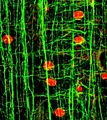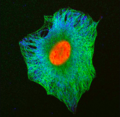Protein filament facts for kids
In biology, a filament is like a long, thin string made of many tiny protein pieces linked together. Think of them as the building blocks that give shape and help things move inside living cells. You can find these protein strings in many places, like your hair, your muscles, or even in the tiny tails that help some cells swim, called flagella.
Contents
What are Filaments?
Filaments are super important structures found inside almost all living cells. They are part of something called the cytoskeleton, which is like the cell's internal skeleton. This skeleton helps cells keep their shape, move around, and even divide into new cells. Without filaments, cells would be like floppy bags!
These amazing structures are made from many small protein units that connect to form long chains. Different types of proteins make different kinds of filaments, each with its own special job.
Types of Filaments
There are three main types of protein filaments that work together to form the cell's cytoskeleton:
Microfilaments
Microfilaments are the thinnest type of filament. They are made from a protein called actin. Imagine tiny, flexible ropes inside a cell.
- What they do: Microfilaments help cells change shape, move, and even divide. They are also super important for muscle contraction. When your muscles move, it's because microfilaments slide past other proteins, making the muscle fibers shorter.
- Where they are found: You can find them just under the cell's outer membrane, helping the cell keep its shape. They are also abundant in muscle cells.
Intermediate Filaments
Intermediate filaments are, as their name suggests, medium-sized. They are tougher and more stable than microfilaments. They are made from various proteins, depending on the cell type. For example, keratin is a type of intermediate filament found in your hair, skin, and nails.
- What they do: These filaments provide strong support and strength to cells, helping them resist stretching and pressure. They are like the steel beams in a building, giving it stability.
- Where they are found: They are especially common in cells that need to withstand a lot of stress, like skin cells or nerve cells.
Microtubules
Microtubules are the thickest type of filament. They are hollow tubes, like tiny straws, made from a protein called tubulin.
- What they do: Microtubules act like tracks inside the cell. They help move things around, like tiny packages of proteins or even whole cell parts. They also form the main structure of cilia (tiny hair-like structures) and flagella (whip-like tails) that help some cells move. During cell division, microtubules form the "spindle" that pulls chromosomes apart.
- Where they are found: They usually grow out from a central point in the cell and extend throughout the cytoplasm, creating a network for transport.
Where Do We Find Filaments?
Filaments are everywhere in living things!
- In your body:
- Hair and Nails: Your hair and nails are mostly made of keratin, a type of intermediate filament. This is why they are strong and tough.
- Muscles: Microfilaments (actin) and other proteins work together to make your muscles contract, allowing you to move, lift, and run.
- Nerve Cells: Intermediate filaments help give nerve cells their long, thin shape, which is important for sending messages throughout your body.
- In plants: Plant cells also have cytoskeletons with filaments that help them grow and maintain their rigid shape.
- In tiny organisms: Many single-celled organisms use flagella or cilia, which are built from microtubules, to swim or move food towards themselves.
Filaments are truly amazing and essential parts of life, helping cells function and giving structure to everything from a tiny bacterium to a giant tree, and even you!
Images for kids
-
Developing wood cells in poplar showing microfilaments (in green) and cell nuclei (in red)
See also
 In Spanish: Filamento proteico para niños
In Spanish: Filamento proteico para niños




